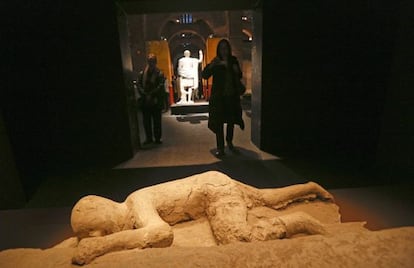Stories from Pompeii
A collection of artifacts from the city brings a lost world to life in Madrid

The life, passion, agony and resurrection of the Roman city of Pompeii will be on show to the public until next May at an exhibition opened last Monday by Madrid regional premier Ignacio González.
A subterranean scene marked by a forest of brick columns and arcades that a few years ago played host to the Terracotta Army of Qin Shi Huang narrates a spine-chilling tale: an occurrence one afternoon in AD 79 that in just 18 hours reduced the pearl of the Neapolitan bay to ashes.
A huge roar from the bowels of Vesuvius, rising above the picturesque Mediterranean coast, foretold the tragedy that was to unfold. A few minutes later its crater emitted a terrible sound; a giant waking from sleep. Masses of molten lava, retained within Vesuvius' depths for centuries, burst from its crater, showering the unsuspecting city with millions of tons volcanic rock. A towering column of toxic and lethal ash rose 15 kilometers into the sky.
Ash covered Pompeii to a depth of seven meters, an ocean of grey desolation. Under this ill-starred shroud the city remained for 1,500 years. In 1594, it became known that 500 people - many of them children, the old and women - had died in excruciating agony in what is considered the worst natural disaster of the ancient world.
Gaius Plinius, or Pliny the Younger, was on hand to record subsequent events. His veteran uncle, Pliny the Elder, commanded the Roman fleet in the bay and rushed to city's aid with rescue boats.
Pliny's narrative has reached us and permits this exhibition - thanks to the scientific expertise of its curator, Martín Almagro and the vivid set design of Ignasi Cristiá - to recreate the comfortable everyday existence of Pompeii's citizens and their sudden demise, and to capture its archeological renaissance in the 18th century. The city owes its name, which means procession in Greek, to the pompe that Hercules embarked on after completing his 12 tasks.
Ten separate displays - the city's origins, the house of national hero Menander, painting, private life, leisure and Pompeii's main thoroughfare among them - bring to life the history of the city and its terrible end, which only the miracle of its conservation under the weight of the ash allowed what occurred there in AD 79 to be known today.
In spite of everything, the fury of Vesuvius was unable to destroy some pieces of art and household items conserved under the blanket of stone, ash and lava. Among them is a 2,000-year-old image of the Greek poet Sappho. The exhibit contains 622 statues, mosaics, ceramic items and pieces of gold and silverwork rescued from the site.
Through the cooperation of archeological museums in the Napoli area and 22 institutions which have loaned exhibits, the Madrid show contains vestiges of the disaster such as the famous preserved bodies of people caught in the aftermath of the eruption.
The exhibition ends with the ring worn by Carlos III of Spain, then ruler of the Kingdom of the Two Sicilies: "the most important archeological king in history," says Almagro. "As an organizer, promoter and manager of archeology, nobody could top him, not even Lord Carnarvon or
Schliemann." A gallery dedicated to the "Spanish Pompeiis" - Segovia and Mérida - contains the majestic first-century Efebo de Antequera , one of the most beautiful Roman sculptures uncovered in Spain and an example of the synthesis of Roman and Greek art.
A spectacular audiovisual offering brings the tragic events of Pompeii to life, the discovery of which in the 16th century and its excavation in the 18th century on the orders of Carlos III wrote an indelible page in the painful history of mankind.
Pompeii. Catastrophe under Vesuvius . Open from 10am to 9pm. Access granted every 30 minutes. Entrance, 6 euros. Until May 5 at Centro de Arte Fundación Canal. Plaza de Castilla.
Tu suscripción se está usando en otro dispositivo
¿Quieres añadir otro usuario a tu suscripción?
Si continúas leyendo en este dispositivo, no se podrá leer en el otro.
FlechaTu suscripción se está usando en otro dispositivo y solo puedes acceder a EL PAÍS desde un dispositivo a la vez.
Si quieres compartir tu cuenta, cambia tu suscripción a la modalidad Premium, así podrás añadir otro usuario. Cada uno accederá con su propia cuenta de email, lo que os permitirá personalizar vuestra experiencia en EL PAÍS.
¿Tienes una suscripción de empresa? Accede aquí para contratar más cuentas.
En el caso de no saber quién está usando tu cuenta, te recomendamos cambiar tu contraseña aquí.
Si decides continuar compartiendo tu cuenta, este mensaje se mostrará en tu dispositivo y en el de la otra persona que está usando tu cuenta de forma indefinida, afectando a tu experiencia de lectura. Puedes consultar aquí los términos y condiciones de la suscripción digital.








































